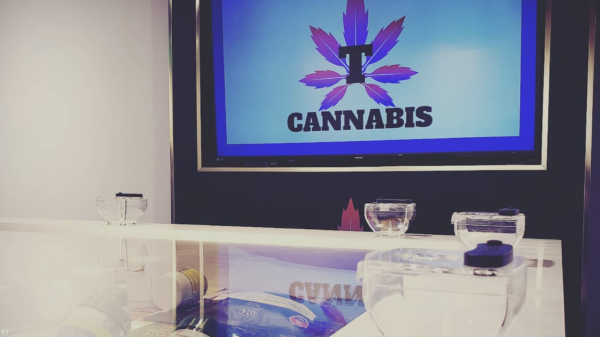Although a widespread consensus points to THC cartridges from the black market as the likely main culprit behind the vaping illness outbreaks in the U.S., medical authorities still haven’t been able to pinpoint the exact cause of the lung disorders. The uncertainty has cast a shadow over the licensed cannabis industry as a whole, dragging down vape sales and share prices for marijuana vaporizer companies.
But doctors studying lung tissue from victims of the sudden respiratory disorder — that has killed at least 20 people across 17 U.S. states since July — provided evidence for the first time that a mix of “toxic chemical fumes” may be to blame, according to the first formal study on the issue.
In the Mayo Clinic report released last week, researchers examined lung biopsies from 17 patients suspected to be linked to the mysterious vape-related outbreak that has sickened 1,080 Americans across 48 states, according to the Centers of Disease Control and Prevention (CDC). Two lung tissue samples came from patients who died.
They found that all 17 cases show a pattern of injury in the lung that looks the same as when people are exposed to chemical weapons used in World War I, such as mustard gas poisoning.
“Although the pathogenesis and the chemical agent(s) responsible for this problem remain unknown, this constellation of histologic changes suggests the possibility of direct lung toxicity from an inhaled noxious agent or agents,” the doctors wrote in the study published in The New England Journal of Medicine.
This means that toxic fumes inhaled from dangerous pesticides is more likely the cause of the epidemic rather than the oils itself or cutting agents like vitamin E oil — a substance that’s been widely suspected as the main culprit.
Originally, medical experts thought the lung disorders matched the symptoms of a rare form of pneumonia when fat particles enter the lungs. But the non-profit medical center’s study showed zero evidence of lipoid pneumonia in each of the cases.
An NBC News investigative report that tested THC vape cartridges, from both illicit and regulated sources, found the majority of the products from unlicensed sources contained vitamin E acetate — but even more alarming, 10 out of 10 of the illegal products contained myclobutanil, a fungicide that can transform into hydrogen cyanide when heated. The licensed products, however, contained no pesticides or oil-based cutting agents.
The authors of the Mayo Clinic report warned the research into the vaping illness outbreak is still in its early stages and the findings are not conclusive.
The CDC has assigned more than 100 doctors and investigators to identify the exact cause of the deadly outbreak. The federal agency has noted the majority of patients appear to be using THC vape products from the black market. But some patients have used both cannabis and nicotine vape devices, and 17 per cent used nicotine products exclusively.
Of the 17 patients in the study, 71 per cent used cannabis vape devices.
Lung damage from #vaping resembles chemical burns, report says. https://t.co/ngKfU227X1 via @nytimes @CDCgov
— Mayo Clinic (@MayoClinic) October 5, 2019
Cannabis vape sales rebounding, Canadian producers remain confident
The vaping-related epidemic has been another dark spot for the cannabis sector, which has already endured a rough scandal-filled summer and seen massive declines in company share prices.
According to New Frontier Data, the market share for marijuana vape products declined an average of 15 per cent in U.S. states that have legalized some form of the drug from the end of July to mid-September.
But for many industry players the crisis offers an opportunity to show licensed products are thoroughly tested and safer than illegal THC vape cartridges.
More than 800 cannabis companies signed a letter to Congress to have marijuana removed from the list of schedule 1 drugs so items like vape products can be regulated and tested.
Meanwhile, HALO Labs (NEO:HALO)(OTC:AGEEF) CEO Kiran Sidhu said in a Midas Letter interview his company has seen sales in vape products balloon since the health crisis first made headlines. Reportedly, other cannabis vape related stocks may be experiencing a similar surge in sales as an increasing number of sources link illegal products with dangerous chemicals.
In Canada, licensed producers are gearing up to release their vape products to the market when cannabis-derivative products become legal later this month and available for sale in December.
The Canadian pot companies are confident in their vape products and say the spate of deaths in the U.S. is likely connected to unregulated THC vapes, which only confirms the safety benefits of legalizing the drug for recreational use.
“The illicit product has no thorough testing,” Ryan Hellard, with Alberta-based Sundial Growers (NASDAQ: SNDL), told Postmedia news.
“Health Canada puts very strict regulations on oil production, flower and packaging … so the resulting product comes from a much more vigourous testing.”
Sundial has been working on two lines of THC vapes and plans to produce a CBD option by next year, according to Hellard.
“Obviously, what’s happening gives us some concern, but we put safety first and foremost,” he said.
Bans on vape products “would simply keep the black market alive,” the cannabis businessman added.
State governors in Massachusetts and Oregon have pushed for bans on sales of all vape products — including regulated items. Oregon his implemented a six-month ban, while Massachusetts has issued a four-month ban.
Washington state Gov. Jay Inslee directed officials to ban the products earlier this month.














